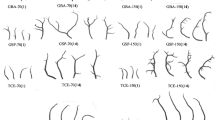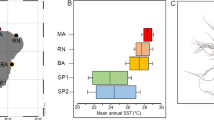Abstract
In order to better understand the alternation of generations that characterizes haploid–diploid life cycles, we assessed the existence of ecological differences between the two phases (haploid gametophyte and diploid tetrasporophyte) in Gracilaria chilensis, a rhodophyte with a typical Polysiphonia-type life cycle. We investigated the effect of light intensity and salinity on viability and growth of both phases at different ontogenetic stages: juveniles and adults. In our study, the survival of juvenile gametophytes (n) was higher than the survival of juvenile tetrasporophytes (2n) despite culture conditions; however, low salinity had greater effect on carpospores (2n) than on tetraspores (n). On the other hand, a complex interaction between salinity and light intensity within each life history phase generated observed differences between juvenile growth rates. Low light was shown to trigger early onset of alteration of the holdfast growing pattern. In addition, adult tetrasporophytes showed, despite the conditions, a faster vegetative growth than female and male gametophytes. These differences between phases could have led to the complete dominance of tetrasporophyte fragments of fronds observed in G. chilensis farms. We hypothesize that Chilean fishers could have unknowingly selected for tetrasporophyte thalli during domestication of the species, thus enhancing the natural trend of tetrasporophytes dominance already present in estuarine natural populations of free-floating plants.






Similar content being viewed by others
References
Akatsuka I (1986) Japanese Gelidiales (Rhodophyta), especially Gelidium. Oceanogr Mar Biol Annu Rev 24:171–263
Bird CJ, McLachlan J (1986) The effect of salinity on distribution of species of Gracilaria Grev. (Rhodophyta, Gigartinales): an experimental assessment. Bot Mar 29:231–238
Bird CJ, McLachlan J, Oliveira EC (1986) Gracilaria chilensis sp. nov. (Rhodophyta, Gigartinales), from Pacific South America. Can J Bot 64:2928–2934
Buschmann AH, Correa JA, Westernmeier E, Hernandez-Gonzalez MDC, Normabuena R (2001) Red algal farming in Chile: a review. Aquaculture 194:203–220
Carmona R, Santos R (2006) Is there an ecophysiological explanation for the gametophyte–tetrasporophyte ratio in Gelidium sesquipedale (Rhodophyta)? J Phycol 42:259–269
Choi HG, Kim YS, Kim JH, Lee SJ, Park EJ, Ryu J, Nam KW (2006) Effects of temperature and salinity on the growth of Gracilaria verrucosa and G. chorda, with the potential for mariculture in Korea. J Appl Phycol 18:269–277
Coelho S, Peters AF, Charrier B, Roze D, Destombe C, Valero M, Cock JM (2007) Complex life cycles of multicellular eukaryotes: new approaches based on the use of model organisms. Gene 406:152–170
Correa JA, McLachlan JL (1991) Endophytic algae of Chondrus crispus (Rhodophyta). III. Host specificity. J Phycol 27:448–459
Cronin G, Hay ME (1996) Chemical defenses, protein content, and susceptibility to herbivory of diploid vs. haploid stages of the isomorphic brown alga Dictyota ciliolata (Phaeophyta). Bot Mar 39:395–399
Destombe C, Valero M, Vernet P, Couvet D (1989) What controls haploid–diploid ratio in the red alga, Gracilaria verrucosa? J Evol Biol 2:317–338
Destombe C, Godin J, Lefebvre C, Dehorter O, Vernet P (1992) Differences in dispersal abilities of haploid and diploid spores of Gracilaria verrucosa (Gracilariales, Rhodophyta). Bot Mar 35:93–98
Destombe C, Godin J, Nocher M, Richerd S, Valero M (1993) Differences in response between haploid and diploid isomorphic phases of Gracilaria verrucosa (Rhodophyta: Gigartinales) exposed to artificial environmental conditions. Hydrobiologia 260/261:131–137
Edding M, León C, Rattcliff A (1987) Growth of Gracilaria sp. in the laboratory. Hydrobiologia 151/152:375–379
Fierst J, ter Horst C, Kubler JE, Dudgeon S (2005) Fertilization success can drive patterns of phase dominance in complex life histories. J Phycol 41:238–249
Fredersdorf J, Müller R, Becker S, Wiencke C, Bischof K (2009) Interactive effects of radiation, temperature and salinity on different life history stages of the Arctic kelp Alaria esculenta (Phaeophyceae). Oecologia 160:483–492
Garza-Sánchez F, Zertuche-González JA, Chapman DJ (2000) Effect of temperature and irradiance on the release, attachment, and survival of spores of Gracilaria pacifica Abbot (Rhodophyta). Bot Mar 43:205–212
Gómez I, Figueroa FL, Huovinen P, Ulloa N, Morales V (2005) Photosynthesis of the red alga Gracilaria chilensis under natural solar radiation in an estuary in southern Chile. Aquaculture 244:369–382
Guillemin ML, Faugeron S, Destombe C, Viard F, Correa JA, Valero M (2008) Genetic variation in wild and cultivated populations of the haploid–diploid red alga Gracilaria chilensis: how farming practices favour asexual reproduction and heterozygosity. Evolution 62:1500–1519
Guimaraes M, Plastino EM, Oliveira EC (1999) Life history, reproduction and growth of Gracilaria domingensis (Gracilariales, Rhodophyta) from Brazil. Bot Mar 42:481–486
Hannach G, Santelices B (1985) Ecological differences between the isomorphic reproductive phases of two species of Iridaea (Rhodophyta: Gigartinales). Mar Ecol Prog Ser 22:291–303
Hoyle MD (1978) Reproductive phenology and growth rates in two species of Gracilaria from Hawaii. J Exp Mar Biol Ecol 35:273–283
Hughes JS, Otto SP (1999) Ecology and the evolution of biphasic life cycles. Am Nat 154:306–320
Hunt R (1982) Plant growth curves. Edward Arnold, London
Juanes JA, Puente A (1993) Differential re-attachment capacity of isomorphic life history phases of Gelidium sesquipedale. Hydrobiologia 260/261:139–144
Kain JM, Destombe C (1995) A review of the life history, reproduction and phenology of Gracilaria. J Appl Phycol 7:269–281
Kraan S, Barrington KA (2005) Commercial farming of Asparagopsis armata (Bonnemaisoniceae, Rhodophyta) in Ireland, maintenance of an introduced species? J Appl Phycol 17:103–110
Lubchenco J, Cubit J (1980) Heteromorphic life histories of certain marine algae as adaptations to variations in herbivory. Ecology 61:676–687
Mable BK, Otto SP (1998) The evolution of life cycles with haploid and diploid phases. Bioessays 20:453–462
Martín LA, Zaixso ALB, Leonardi PI (2010) Biomass variation and reproductive phenology of Gracilaria gracilis in a Patagonian natural bed (Chubut, Argentina). J Appl Phycol 23:643–654
Maynard-Smith J (1978) The evolution of sex. Cambridge University Press, Cambridge
Patwary MU, van der Meer JP (1984) Growth experiments on autopolyploids of Gracilaria tikvahiae (Rhodophyceae). Phycologia 23:21–27
Pizarro A, Santelices B (1993) Environmental variation and large scale Gracilaria production. Hydrobiologia 260/261:357–363
Prieto I, Westermeier R, Muller D (1991) Variation of phenophases of Gracilaria chilensis Bird, McLaughlin and Oliveira (Rhodophyta, Gigartinales) in laboratory and field culture conditions: presence of mixed phases. Rev Chil Hist Nat 64:343–352
Quinn GP, Keough MJ (2002) Experimental design and data analysis for biologists. Cambridge University Press, Cambridge
Raikar SV, Iima M, Fujita Y (2001) Effect of temperature, salinity and light intensity on the growth of Gracilaria spp. (Gracilariales, Rhodophyta) from Japan, Malaysia and India. Indian J Mar Sci 30:98–104
Raper JR, Flexer AS (1970) The road to diploidy with emphasis on a detour. Symp Soc Gen Microbiol 20:401–432
Santelices B, Varela D (1995) Regenerative capacity of Gracilaria fragments: effects of size, reproductive state and position along the axis. J Appl Phycol 7:501–506
Santelices B, Vásquez J, Ohme U, Fonck E (1984) Managing wild crops of Gracilaria in Central Chile. Hydrobiologia 116:77–89
Santelices B, Westermeier R, Bobadilla M (1993) Effects of stock loading and planting distance on the growth and production of Gracilaria chilensis in rope culture. J Appl Phycol 5:517–524
Thomsen MS, McGlathery KJ, Schartschild A, Silliman BR (2009) Distribution and ecological role of the non-native macroalga Gracilaria vermiculophylla in Virginia salt marshes. Biol Invasions 11:2303–2316
Thornber CS (2006) Functional properties of the isomorphic biphasic algal life cycle. Integr Comp Biol 46:605–614
Thornber C, Stachowicz JJ, Gaines S (2006) Tissue type matters: selective herbivory on different life history stages of an isomorphic alga. Ecology 87:2255–2263
Weinberger F, Buchholz B, Karez R, Wahl M (2008) The invasive red alga Gracilaria vermiculophylla in the Baltic Sea: adaptation to brackish water may compensate for light limitation. Aquat Biol 3:251–264
West JA, Zuccarello GC (1999) Biogeography of sexual and asexual reproduction in Bostrychia moritziana (Rhodomelaceae, Rhodophyta). Phycol Res 47:115–123
Westermeier R, Rivera PJ, Gómez I (1991) Cultivo de Gracilaria chilensis Bird, McLachlan y Oliveira, en la zona intermareal y submareal del estuario Cariquilda, Maullín, Chile. Rev Chil Hist Nat 64:307–321
Williams SL, Smith JE (2007) A global review of the distribution, taxonomy, and impacts of introduced seaweeds. Annu Rev Ecol Evol Syst 38:327–359
Zhang X, van der Meer JP (1987) A study of heterosis in diploid gametophytes of the marine red algae Gracilaria tikvahiae. Bot Mar 30:309–314
Zuccarello GC, Yeates PH, Wright JT, Bartlett J (2001) Population structure and physiological differentiation of haplotypes of Caloglossa leprieurii (Rhodophyta) in a mangrove intertidal zone. J Phycol 37:235–244
Acknowledgments
This research was funded by Fondo Nacional de Desarrollo Científico y Tecnológico, Gobierno de Chile (FONDECYT #1090360) awarded to M-L. Guillemin. This study also constitutes a contribution from the Associated International Laboratory between France and Chile “Dispersal and Adaptation in Marine Species” (LIA DIAMS). We thank V. Flores, F. Rubio and N. Lavado for their help during the field sampling and the laboratory experiments and D. Roze and M. Valero for their helpful comments. We are also grateful to two anonymous reviewers for improving the early version of the manuscript.
Author information
Authors and Affiliations
Corresponding author
Rights and permissions
About this article
Cite this article
Guillemin, ML., Sepúlveda, R.D., Correa, J.A. et al. Differential ecological responses to environmental stress in the life history phases of the isomorphic red alga Gracilaria chilensis (Rhodophyta). J Appl Phycol 25, 215–224 (2013). https://doi.org/10.1007/s10811-012-9855-8
Received:
Revised:
Accepted:
Published:
Issue Date:
DOI: https://doi.org/10.1007/s10811-012-9855-8




